With its eyes on the next Commission and the next ‘multi-annual financial framework’ (budgetary period from 2021 to 2027), the Commission started producing some ‘white papers’ four or five years ago outlining its approach to a number of key issues. One of them was defence.
The Commission produced what it called a ‘reflection paper on the future of European Defence’, published in June 2017 and signed off by two vice-presidents of the Commission, one of whom was the High Representative, Federica Mogherini.
This ‘white paper’ is a fascinating document which has been worth keeping over the last five years even though many things have happened during the intervening period. Its foreword declared that ‘it is time to consider concrete ambitions with respect to the future role of the Union in security and defence,’ concluding that ‘the stakes for Europe and our citizens are very high.’ Five years later, it is hard to imagine that those writing the foreword knew quite how high the stakes would become.
The paper is full of graphs and diagrams, including one that compares the military forces of what was then the EU-28 and the USA. Of course, the EU forces will have been reduced post Brexit, but the figures for 2017 remain very revealing of some of the problems with the EU’s defence capability. The report pointed out that total defence spending (in 2017) in the EU was slightly less than half that of the USA (227 billion dollars as opposed to 545 billion), which is probably more than most people suppose.
However, it then contained a section entitled: ‘duplication of systems in use’. It proceeded to list them. Main battle tanks – in the case of the USA, there was one type of tank; in the case of the EU there were 17. Then came destroyers and frigates. In the case of the USA, there were four different types. In the case of the EU, there were twenty-nine. Finally, fighter planes. In the case of the USA, six different types. In the case of the EU, twenty.
The point of the Commission’s report was to highlight duplication in defence spending, and its overall message was clear. It was all very well to highlight the need for those countries that were NATO members to reach the 2% of GDP spent on defence that was required of them (this was the first year of Trump’s presidency and he was already making waves about NATO members failing to pull their weight). But a far bigger issue than the requirement to spend 2% was the requirement to spend it in a coordinated manner.
Those 29 different types of destroyer/frigate or 17 different types of tank were not an example of flexibility but of failure to coordinate with one another, whether in procurement or in production. The claim of protecting ‘national interests’ and ‘national security’ was and is a very convenient way of ensuring that your military spending is kept in-house.
Only your own workers can build the tanks you need and it would be a betrayal of national secrets to let anyone else in on the process. The result is 17 different types of tank trundling over the battlefield and good luck to the general who’s supposed to point them in the same direction.
The last few weeks alone have shown how vital it is for the EU to work towards a common energy policy and a common defence policy. But it should avoid the distraction of pretending that the issue is about ‘spending more’, as if it is a case of Europeans preferring to spend on butter than on guns.
To quote the reflection report, ‘we need to increase the scope and efficiency of defence spending’ (note that it did not say ‘the amount’). It went on to point out that ‘duplications between member states can affect the interoperability of their defence equipment’. It concluded that ‘to address this, member states’ defence spending should be better coordinated.’
Five years on, that need for coordination has become overwhelming. As the Commission’s report recognized five years ago, what’s really important is not to spend more but to spend more wisely. And that means a level of cooperation among the EU-27 that has been sorely lacking in the defence field so far.

